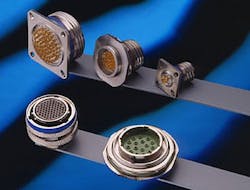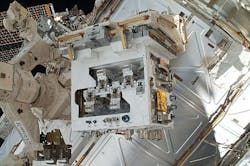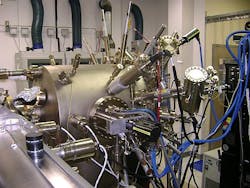Aerospace and defense designers weigh considerations in selecting the right connectors
TECHNOLOGY FOCUS, 8 Feb. 2012. Systems designers and systems integrators have openly admitted to treating connectors as something of an afterthought in years past. Today, however, interconnect technology often is a central focus and concern for engineers championing efficient, effective, and innovative electronic systems for aerospace and defense applications.
Military connectors, it turns out, are critical to today’s network-centric and data-intensive battlefield. Without proper connectivity, individual systems and nodes on a network—both within a single aircraft or ground vehicle and across broad geographic expanses—cannot relay what is essential, be it power or data. Systems architects and systems integrators, therefore, often labor over the selection of the optimal connectors, upon which end users rely to maintain smooth, reliable, and consistent speed and throughput.
“With all the advances in processor speeds, sensor detail output such as much higher resolutions, as well as significant increases in data storage capacities for intelligence, surveillance, and reconnaissance (ISR) acquisition, the requisite input and output (I/O) of data between those systems and subsystems has fallen behind,” admits Dr. Thomas Steding, president and CEO of Zephyr Photonics, a Zephyr Cove, Nev.-based maker of wide temperature range, optical interconnects for harsh environments. “There is a critical demand for high-speed, interconnect components that support those enhanced capabilities and requirements for I/O in military and space applications.”
Needs and requirements
In a majority of aerospace and defense systems, applications, and environments, not just any connector will do; rather, mil-aero system designs often carry myriad requirements. “As avionics and their constituent sensor and processing capabilities are upgraded and continue to grow, the need increases for bandwidth as well as interconnect flexibility; size, weight, and power (SWaP); EMI resistance; and system reliability and maintainability,” Steding describes.
Size, weight, and power (SWaP) restrictions, common in virtually all aerospace and defense programs today, apply to the system I/O.
Interconnect Devices Inc. (IDI) in Kansas City, Kan., specializes in connectors used in applications requiring extremely low profiles and blind mating capability, says Tim Dowdle, senior manager of business development at IDI. “IDI’s spring probe-based connectors are the only technology capable of blind mating in five different axis simultaneously. Pin and socket technology simply can’t be used here.”
IDI engineers developed a series of spring pin-based connectors for the Multiple Integrated Laser Engagement System (MILES), a widely used training system that provides tactical engagement simulation for direct fire force-on-force training using eye-safe laser "bullets." It employs a detection system to sense hits and perform casualty assessment. Laser transmitters are attached to each soldier and vehicle weapon system to replicate the range and lethality of the specific weapon systems. The MILES system—used by a wealth of military organizations across the globe, including U.S., British, Australian, Czech, Estonian, German, Hungarian, Indian, Irish, and other armies—also has law enforcement applications.
For MILES, IDI delivered connectors that are “lightweight, durable, and simple to operate--all of which is required for training hardware that is worn by military personnel,” Dowdle affirms. MILES XXI, the latest version of the training system, is provided by Lockheed Martin in Bethesda, Md.
Harsh environments
Aerospace and defense systems often must be capable of extended operation in harsh environments. Connectors must withstand myriad environmental conditions, from heavy shock and vibration to wide temperature extremes. Systems designers and systems integrators are increasingly looking to fiber-optic technology to meet mil-aero connectivity needs.
Zephyr's optical interconnect designs that incorporate its vertical-cavity surface-emitting laser (VCSEL) technologies allow it to develop optical interconnect components that meet the specifications for harsh, uncontrolled environments encountered in military and aerospace applications, according to Steding. “This unique and new capability allows interconnect designs that can use fiber in applications that heretofore could only use heavily shielded copper cabling. The selection of optical interconnects needs to be a SWaP-efficient and maintenance-friendly solution.”
Fiber-optic adoption
Companies are very interested in integrating fiber into avionic/mission systems, describes Ben Jeffrey, group manager, industry marketing at Molex Inc. in Lisle, Ill. “We will see more use of fiber-optical solutions in [mil-aero] systems due to high-bandwidth requirements and better immunity to interference/jamming,” he says. “The VITA 66 fiber-optic backplane connector standard is also drawing attention in the industry, based on the standardization of fiber-optic interconnects from the backplane into any avionics or mission system.”
The increased use of full-motion video on the digital battlefield is driving the demand for high-speed, high-bandwidth optical technologies. “We are continuing to see convergence between networking technologies and military applications, such as streaming high-definition videos and other high-bandwidth applications,” Jeffrey admits.
Zephyr Photonics’ optical interconnects are currently used to address bandwidth issues in harsh environments for both military applications and avionics platforms, Steding describes. The company is actively developing products to solve challenges on both avionics and space platforms for major prime contractors, he says.
Unmanned avionics
Dowdle and his team at IDI are working with several customers who are developing systems that require specialized connector systems. Most of these systems are for future unmanned applications, he says.
“Unmanned vehicles work in the widest array of environments possible. Unmanned aerial vehicle connectors are usually inside a sealed environment, but they can be subject to constant vibrations and high G (G-force) loads,” Dowdle recognizes. “Because weight is the natural enemy of flight, aerial vehicle connectors need to be as light as possible without sacrificing reliability under shock and vibration.” IDI engineers are developing a new interconnect system that will be less than half the weight of previous connector solutions.
“Mil-aero connectors will continue to become more specialized,” Dowdle predicts. “As the electronic battlefield continues to grow and replace traditional battlefield environments, the number of electronic circuits used in military operations will continue to expand.
“IDI continues to develop custom connectors that are more and more integrated with the shape of the vehicle in which they are carried. Curves and even more complex shapes for connector housings minimize the amount of dead airspace inside of an unmanned vehicle,” Dowdle adds. “Also, connectors that embrace the continuing marriage of man to machine continue to increase in demand.”
Space connectivity
Space is considered to be among the harshest environments for electronics systems and components. Many space applications, therefore, require custom solutions. The last flight of the Space Shuttle Atlantis (STS-135) was such an application, calling for special connectors for NASA’s Robotic Refueling Mission (RRM) module.
The RRM module is thought to pave the way for on-orbit refueling and servicing of satellites, which are not designed with the intention of accessing the fuel tank once they arrive in orbit. The RRM includes four specialized tools to enable DEXTRE to access the fuel port and transfer fuel to the satellite’s tank, which is covered by a series of seals, caps, and thermal blankets. This capability is expected to extend the life of satellites that depend on liquid fuel for maneuvering and orbit-conservation.
Cost and COTS
Aerospace and defense technology experts acknowledge that connectors can add considerable cost to a system. “The cost of silicon keeps going down, whereas the price of metal hasn’t budged,” admits Bill Kehret, president and CEO of Themis in Fremont, Calif. As a result, the cost of a required hermetically sealed connector with gold-plated pins can easily exceed that of all other electronic components in the system.
A growing trend is the recognition that military-specific connectors in some cases unnecessarily increase the cost of the system, acknowledges Jeffrey.
Molex connectors are used in many aerospace and defense applications, such as avionics, tactical vehicle systems (Vetronics), night-vision systems, missiles, UAVs (unmanned aerial vehicles) and UAV control stations, radios, and radars, Jeffrey explains. “Molex products meet the needs of mil-aero integrators and system designers: They are rugged, hazardous duty-proven interconnects; the interconnects are high-bandwidth, high-speed, and high-current networking interconnects; and the fiber-optic, radio-frequency (RF), and flex circuits are already in use in industrial applications.
In the attempt to add commercial off-the-shelf (COTS) components to networking systems, companies are looking at ruggedized versions of traditional commercial applications, such as high-speed I/Os, Jeffrey notes.
The need for rugged and ruggedized hardware in mil-aero environments is unlikely to subside, however, especially as high power demands continue to rise. “Alternative energy will become paramount as supplying energy is costly and high risk; and, ruggedized interconnects are essential to the success of alternative energy applications.”
Company list
AboveNet Communications Inc.
White Plains, N.Y.
866-859-6971
www.above.net
Agilent
Santa Clara, Calif.
877-424-4536
www.agilent.com
Airborn
Addison, Texas
972-931-2818
www.airborn.com
Alcatel-Lucent
Murray Hill, N.J.
908-508-8080
www.alcatel-lucent.com
Amphenol Aerospace
Sidney, N.Y.
800-678-0141
www.amphenol-aerospace.com
AVX Corp.
Fountain Inn, S.C.
843-448-9411
www.avx.com
Carlisle Interconnect Technologies
St. Augustine, Fla.
800-458-9960
www.carlisleit.com
DiCon Fiberoptics
Richmond, Calif.
510-620-5000
www.diconfiberoptics.com
Emerson Connectivity Solutions
Bannockburn, Ill.
847-739-0300
www.emersonconnectivity.com
FCI
Etters, Pa.
800-237-2374
www.fciconnect.com
Fischer Connectors US
Alpharetta, Ga.
678-393-5400
www.fischerconnectors.com
Glenair Inc.
Glendale, Calif.
818-247-6000
www.glenair.com
Harwin Plc
Salem, N.H.
603-893-5376
www.harwin.com
Hypertronics Corp.
Hudson, Mass.
978-568-0451
www.hypertronics.com
Interconnect Devices Inc.
Kansas City, Kan.
913-342-5544
www.idinet.com
ITT Interconnect Solutions
Santa Ana, Calif.
714-557-4700
www.ittcannon.com
KVH Industries Inc.
Middletown, R.I.
401-845-2443
www.kvh.com
Lightwave Logic
Newark, Del.
302-356-2717
www.lightwavelogic.com
Molex Inc.
Lisle, Ill.
800-786-6539
www.molex.com
Omnetics Connector Corp.
Minneapolis
763-572-0656
www.omnetics.com
Optical Interconnect
Dallas
866-493-3588www.opticalinterconnect.com
PEI-Genesis
Philadelphia
800-642-8750www.peigenesis.com
PIC Wire & Cable
Sussex, Wis.
877-742-9473
www.picwire.com
Samtec
New Albany, Ind.
812-944-6733
www.samtec.com
Souriau USA
York, Pa.
717-767-7966
www.souriau.com
Spectrum Control
Fairview, Pa.
814-474-1571
www.specemc.com
TE Connectivity
Middletown, Pa.
800-522-6752
www.te.com
Teledyne Storm Products
Woodridge, Ill.
630-754-3300
www.teledynestorm.com
Timbercon Inc.
Lake Oswego, Ore.
800-221-6992
www.timbercon.com



